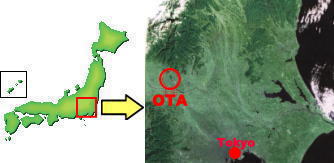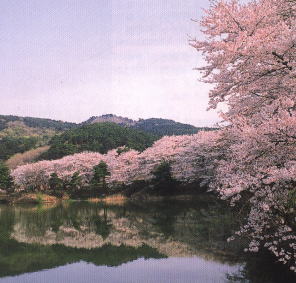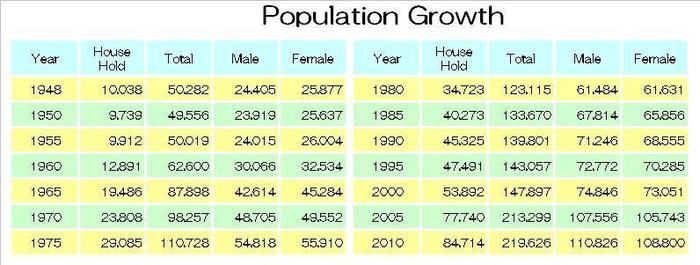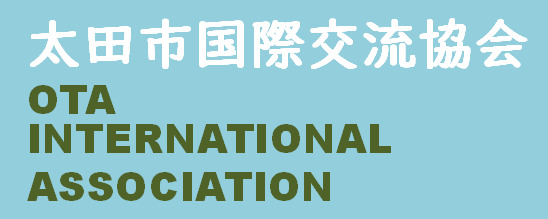本文
Outline of Ota City


Kanayama
The city of Ota is situated in the north-west section of the Kanto Plain in the south-eastern part of Gunma prefecture, at longitude 139 degrees 22 minutes east and latitude 36 degrees 17 minutes north.
Just 86 miles from Tokyo, one can reach Asakusa station via the Toubu-Isesaki line express train in only 90 minutes. Further, the Jouetsu Bullet Train and access to the national highway network via the Tohoku and Kanetsu expressways can be reached within 30 to 40 minutes. Further still, portions of the Kita-Kanto Expressway traversing the Northern Kanto Plain are being completed. When the entire construction is finished 2011, it will serve as a main artery for industry and culture, giving direct access to the Pacific Ocean and providing a tremendous boost of direct highway access convenience for the city.

With a total area of 175.54 square kilometers (67.82 square miles), Ota city is 16.6 kilometers wide (10.31 miles) north to south and 16.8 kilometers long (10.44 miles) east to west. The city limits have a circumference of 59.60 kilometers (37.03 miles).
To the east, the Watarase river runs between Ota and Ashikaga City, Tochigi prefecture. To the south the Tone river is the boundary between Ota and Saitama prefecture through which one can pass to Kumuagaya city and on to Tokyo. To the north lies Kiryu City with which the city of Ota maintains a good relationship.
The elevation of Ota City is on average 30 to 110 meters (98.43 to 360.89 feet) above sea level. In the center of the city lies Kanayama. At 239 meters (784.12feet) above sea level, this mountain is the symbol of Ota City.
In terms of climate, the average annual temperature is a relatively mild 14 degrees Celsius (57 degrees Fahrenheit). On average there are 2 hundred days of clear weather per year. Throughout the four seasons, clear weather prevails. During the winter, there are usually only 2 or 3 days of snow, however there are many days when a strong, dry wind (known as the Joushuu Kara Kaze) blows out of the north-west.


City Hall
History
Although the Japanese people of today are thought of as being all of a single, relatively unique race, these islands were originally peopled by successive waves of migration, probably initially coming across a land bridge that once connected Japan with the continent of Asia. Fossilized bones of humans have been found in parts of Japan, including parts of Gunma, dating back as far as 200,000 years ago. Stone age implements unearthed in the Ota area provide evidence that people were living in this very region as early as 15,000 years ago. Pottery from the Jomon era (7000- 250 BC) and the Yayoi era (250 BC - 300 AD) has also been found in the area suggesting that the area has been continuously inhabited throughout.
Some of the eastern Japan’s grandest Kofun - huge burial mounds erected for rich powerful families during the Yamato period (300 - 645 AD) - have been found in the area. Tenjin Yama, a burial mound that lies within the city limits, is an excellent example.

Tenjin Yama
 Haniwa are often found in connection with burial mounds. Haniwa are earthenware figures shaped to resemble warriors and horses that were placed on the slope of a burial mound to act as guardians. The Haniwa unearthed in Ota are the only Haniwa to be designated as national treasures, and are on display in the National Museum in Tokyo.
Haniwa are often found in connection with burial mounds. Haniwa are earthenware figures shaped to resemble warriors and horses that were placed on the slope of a burial mound to act as guardians. The Haniwa unearthed in Ota are the only Haniwa to be designated as national treasures, and are on display in the National Museum in Tokyo.
From the closing years of the Nara period (710- 794) to the early days of the Heian Period (794 - 1185),this area served as a staging area, providing food, weapons and manpower for wars against the Ezo people who inhabited the northern part Japan.
During Japan’s middle ages, a local family rose to prominence whose descendants would later play leading role in some of the most interesting drama in Japanese history.Yoshishige Nitta was the founder of the powerful Nitta family. Near the end of the Kamakura period (1185-1333), all real power in Japan lay in the hands of the Shogun.There has always been an Emperor, but much of the time in Japanese history, the Emperor has been a mere figurehead.
Such was the case during the reign of the Emperor Go-Daigo. Unhappy with his role as a figurehead, he decided to try to wrest power from the hands of the Shogunate. He began a small revolt in 1331. The revolt was a failure, and Go-Daigo was deposed and exiled. A new Emperor was named from a different line of the royal family. From his place in exile Go-Daigo was able to rally support to his cause. Among his local supporters were Takauji Ashikaga and Yoshisada Nitta, eighth head of the Nitta family.
In 1332 Go-Daigo escaped from exile to lead and all-out revolt. Takauji Ashikaga captured Kyoto, the imperial capital and helped Go-Daigo return to the throne. Meanwhile, Yoshisada Nitta captured Kamakura and destroyed the Shogun. There were still two Emperors, and the battle for supremacy carried on for the next sixty years. This period in Japanese history is known as the North South Dynasty period. Eventually, Ashikaga was alienated by Go-Daigo’s proposed reforms. He recaptured Kyoto causing Go-Daigo to flee. Two years later, Takauji Ashikaga established the Ashikaga Shogunate.

Daikoin Temple

Yoshisada Nitta
Iezumi Iwamatsu was another prominent local figure. His father was an Ashikaga and his mother was from the Nitta family. Mr. Iwamatsu was responsible for the rebuilding of Kanayama castle and he ruled a large part of Ota. During the turbulent years of the North and South Dynasties, he managed to hold onto his power by changing his allegiance between the warring parties depending upon which side appeared to have to the upper hand. He was eventually betrayed by one of his retainers, Mr. Yokoze, who assumed control of Kanayama castle and much of Ota, changing his name to Yura. He was later defeated and expelled from Kanayama castle by the powerful Hojo family. When the Hojo fell from power, the Kanayama castle was reduced to ruins.
At the beginning of the Edo period, which ran from 1600- 1868, Ieyasu Tokugawa and his supporters defeated the forces of the previous Shogun in a pivotal battle, and soon after that he became Shogun. In Ota he commissioned the building on Daikoin Temple at the foot of Kanayama. The temple was built to honor and enshrine the spirit of Yoshishige Nitta. Tokugawa persuaded the then famous monk Donryu to act as founder and first head priest of Daikoin. Donryu was well known for his compassion for children, and the temple soon became a place where they took a keen interest in the education and welfare of the local children. Today people still go to Daikoin Temple (often called "Donryusama" locally) to pray for health and prosperity for their children.
After the death of Ieyasu Tokugawa, his spirit was enshrined at Toushogu Temple in Nikko. It soon became traditional for the Shogun and all of the nation’s important regional leaders to make an annual pilgrimage to Nikko. Those traveling from many parts of Japan passed through Ota on the road to Nikko. Ota enjoyed a boost in prosperity and prestige as a stop over point on the road to Nikko.
Hikokuro Takayama was a prominent and eccentric figure from the Edo period. A citizen of Ota, he traveled all over the country. His acquaintances ranged from court nobles to powerful samurai to rich merchants to lowly farmers. He traveled the country learning, teaching and preaching reverence for the Emperor.
With the end of the Edo period and the Shogunate, the annual pilgrimages to Nikko came to an end. Ota’s brush with fame and national influence ended, too.
In the sixth year of the Taisho Period-1918-Ota became the site of the building of Japan’s first passenger airplane. Starting in 1932 and lasting through World War 2, the Nakajima airplane factory of Ota turned out airplanes. After the war the Nakajima factory converted to the manufacture of automobiles and became Fuji Heavy Industries, makers of the world famous Subaru line of automobiles.
Population
In a census conducted in 1948, the population of this city stood at 50,282 making Ota was the fifth largest city in Gunma prefecture. At about that time, Ota began to annex some of the surrounding villages, making them a part of the city. The pace of this expansion increased around 1955 due to national legislation aimed at consolidating many of the country’s small towns and villages into larger units.
For Ota this legislation led to a rapid succession of mergers over the next ten years. In April of 1957, the villages of Godo and Kyuuhaku became a part of the city, followed by Yabakawa village in July of 1960, Housen village in April of 1963 and Morita village in December of that same year. By the end of this flurry of mergers, Ota had increased in area to the current 97.96 square kilometers.
In 1965, Ota had 87,898 residents living in 19,486 households. By 1975 that number had increased to 110,728 in 29,085 households. In 1985 the population of Ota was 133,670 people sharing 40,273 households making the city third in the prefecture after the nearby cities of Maebashi and Takasaki.
The tendency for rapid population increase in the city has slacked off slightly in recent years, and as of October 1, 2000 the population stood at 147,897. On March 28, 2005, Ota City merged with the towns of Ojima-Machi, Nitta-Machi, and Yabuzukahon-Machi, bringing the population to 218,033. As of March 31, 2008, the population was 218,981 (110,487 males, 108,484 females) and the number of households was 82,931 (the number of foreign nationals: 8,792; households: 4,599).
Foreign residents make up a rather large portion of Ota’s population. Immigration laws were revised in 1990 leading to an increase in the number of registered foreign residents living and working in the city. As of April, 2001 that number stood at 7,303 accounting for more than 5% of the total population.
As of April 2008, the number was 8,744, and made up about 4% of the total population. Due to the recession,the number has fallen to 7,351 as of April 2011,which is about 3.3% of the total population.
Economy and Industry
During the years before World War 2, airplane production was the industrial mainstay of Ota. After the war, much of the skills and technology used in the production of aircraft was redirected into the production of automobiles. The years between 1955 and 1965 brought vigorous economic growth to the area. During that time many of the local factories were built as well as and much of the public housing needed to accommodate the growing work force.
With an annual industrial output exceeding 1.72 trillion yen(as of 2009), Ota ranks first in Gunma prefecture and is on a par with large industrial cities on the northern Kanto area such as Utsunomiya city and Kamisu city. Machinery, metal products and textiles account for more than 85% of the total industrial output. In terms of employment, 34% of the work force are employed in the transportation industry followed by 13.7% in machinery and 11.5% in the electronics.

Distribution Estate

Industrial Estate
In terms of agriculture, rice is the main crop grown in the area. There are some farms that specialize in the cultivation of fruit, flowers and vegetables. In particular watermelon,spinach,strawberries and yamatoimo(a sort of yam) grown in this area are predominant in the marketplace.
Ota also has many historical sites that attract tourists from all over Japan. Rich, green Kanayama, Daikoin Temple and Kinryuu Temple are just a few of the local places that served as backdrops to the area’s colorful history.
Education and Culture
Education is of vital importance to the people of Ota. There are 21 kindergartens,43 nursery schools, 27 elementary schools, 17 junior high schools and 2 schools for children with learning disabilities. There are also 8 high schools; 1 municipal, 6 prefectural and 1 private. Ota is also home to Kanto Gakuen College (Kanto Teachers College). 90% of all preschool age children in the city receive some kind of preschooling before entering the school system. The city has an abundance of facilities available to help youngsters begin their education, and help is available with the expense involved in entering kindergarten. It is the goal of city educators to stay in close touch with the needs of the population to provide a high level of education for the area students.

Sports Park

Tomo Cultural Education Center
Ota city is also deeply committed to the promotion of life long learning for all citizens through a variety of programs. There are about 200 cultural organizations and about 800 sports related clubs in the city. Classes and activities are offered through all of the city’s community centers. Other facilities for the promotion of culture, recreation and education include; the General Society Education Center, Tomo Cultural Education Center, Sports Park and Kanayama Camp Ground.





